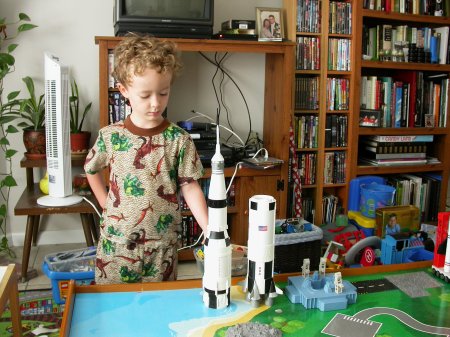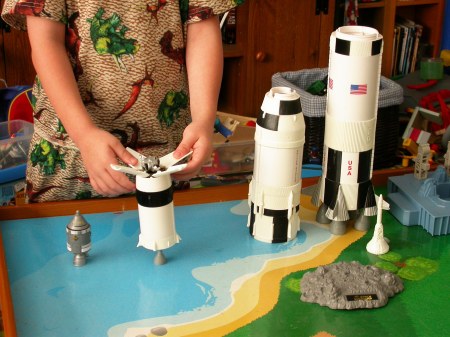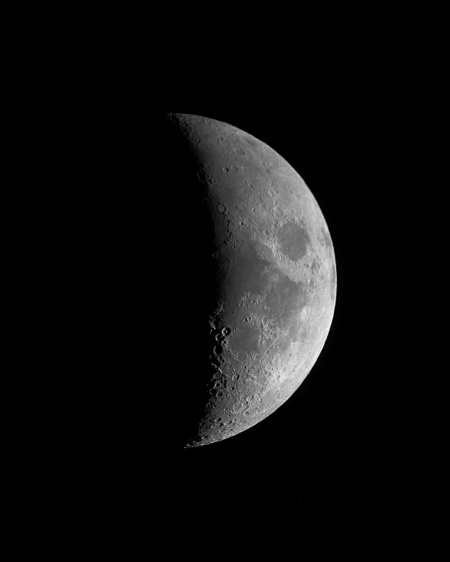
The moon from downtown Claremont yesterday evening, taken with a Nikon Coolpix 4500 digital camera held up to the eyepiece of my 3.5 inch telescope.
Mission Objectives: The Moon, Sky Motions
Equipment: Naked eye
Required Time: 1 minute, every few nights, for one month
Instructions: Follow the moon through one complete cycle of phases. Should be easy enough, right–you’ve seen it, what, about a million times in your life? But do you know where it is right this minute?
The moon orbits the Earth in the same direction that the Earth spins, west to east (counterclockwise if you’re looking down on the North Pole). The west-to-east rotation of the Earth means that when you’re on Earth, stuff in the sky appears to move from east to west–most notably the sun, but also the stars and the moon. The stars might as well be bolted to the dome of heaven for all the motion they reveal to the casual stargazer (beyond the basic rising and setting). The apparent motion of the sun is different–as the Earth swings around it in orbit, the sun appears to make one complete circuit of the sky each year, at a rate of a little more than 1 degree per day (360 degrees/365 days). The apparent motion of the moon is also different; the moon is orbiting the Earth every 27.3 days, so it makes one complete circuit of the sky (relative to the background stars) in that time, at about 13 degrees per day.
BUT the Earth is still spinning west to east, and going much faster than the sun or the moon are relative to the background stars; from Earth, the background stars themselves appear to turn 360 degrees in 24 hours, at about 15 degrees per hour. So the predominant motion of the moon in the sky is still the east-to-west progression that we expect from the sun, the stars, and everything else up there. But the moon is moving around us west-to-east, so it appears to go more slowly than the sun. Each day the moon is a bit more than 13 degrees farther from the sun. You may also think of it like this: the moon completes an orbit in 27.3 days, and there are 24 hours in a day, so each day the moon rises and sets about an hour later, until it has come back around to where it started, one month hence.
If all that makes your brain hurt–and it sometimes does mine–let’s try it with pictures. Imagine that you are standing in an open field at sunset, facing south (better yet, arrange to be in an open field at sunset, facing south!). If it just a couple of days after the new moon, this is what you’ll see:
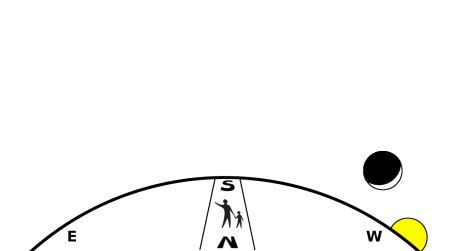
Of course you know that the moon is tidally locked to the Earth and always shows us the same face; all that changes from our perspective is how much light falls on the near face. There is no “dark side of the moon”, just a near side and a far side, and over the course of a month they receive equal amounts of sunlight and darkness.
In the diagram above, showing a young crescent moon, the moon has not yet moved very far from the sun; in fact, is still very far sun-ward of the Earth. Most of the sunlight is falling on the far side of the moon, but the moon is enough off to one side of the Earth-Sun line that a little light spills over to the near side.
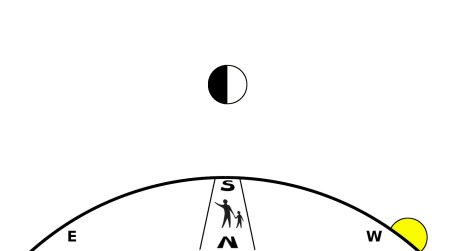
The next night the moon will rise about an hour later and be about 13 degrees farther from the sun in the sky. From being in between the Earth and Sun, the moon is moving around to be beside the Earth, relative to the sun. When it gets there, then it will be halfway up the sky at sunset, and halfway illuminated on the near side. This is the first quarter moon, and it’s absolutely the best time to haul out binoculars or a telescope and see the play of light and shadow over the craters, mountains, and valleys of la Lune.
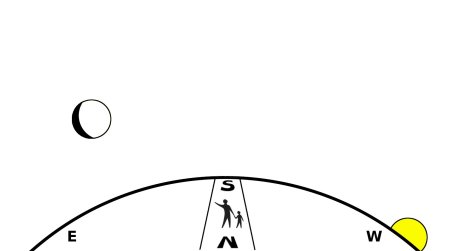
Once past first quarter, the moon continues to rise later and is consequently less far up the sky when the sun sets. But now the near face is turned more squarely to the sun and appears more fully lit. This more-than-half-lit condition is gibbous, and since the moon is getting fuller each night, it is a waxing gibbous moon.
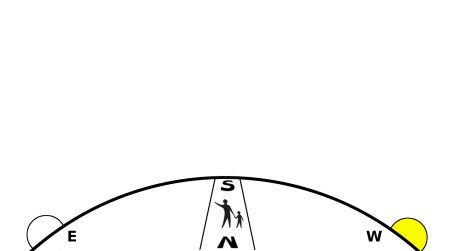
Eventually, about two weeks after new moon and one week after first quarter moon, the moon rises at the same time that the sun sets. The moon and sun are now precisely opposite each other in the sky, so the near face is entirely lit and the moon is full. Once in a while things line up so that the Earth is exactly between the sun and moon, and the shadow of the Earth on the moon creates a lunar eclipse. It should be obvious that a lunar eclipse can only occur at full moon.
That doesn’t mean that a lunar eclipse can only occur at sunset; the moon may become maximally full when it is halfway across the sky (and the sun is halfway between rising and setting), or during the day, or at any other time. Another way to think of it: whenever a lunar eclipse occurs, it will be at sunset for somebody, somewhere–and sunrise for someone else, and midnight for someone else, and noon for someone else.
Most months there is no eclipse, because the moon’s orbit describes a slightly different path in the sky than the Sun, and the moon passes over or under the sun from our vantage point. If everything was in perfect alignment, we’d have a lunar eclipse every full moon, and a solar eclipse every new moon.
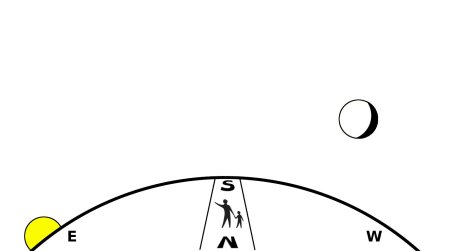
What happens after full moon? The moon continues to rise an hour later each night, but it has now gone past the point where it was opposite the sun in the sky (full moon), and starts to approach the sun from the other side. From our standpoint, it looks like the sun is catching up to the moon. From full moon to new moon the same phases pass–gibbous (mostly lit), quarter (half lit), crescent (less than half lit)–but in reverse order, and you have to stay up later and later to see them against a dark sky.
Eventually as the moon rises later and later, there comes a day when it rises at the same time as the Sun. In other words, the moon is now squarely between the Earth and Sun, the far side is entirely lit, the near side is entirely dark, and we can’t see the moon in the sky at all. This is the new moon, and in nights to come the moon will rise a bit later, trail the sun across the sky, and first be visible as a thin crescent low in the west at sunset, as in the first diagram up top. It should be obvious that a solar eclipse–when the moon gets squarely between the Earth and Sun, and the shadow of the moon falls on the Earth–can only happen at new moon.
You don’t always have to stay up late (or get up early) to see the waning phases. In a month, the moon spends just as much time in the daytime sky as it does in the nighttime sky. Think about it–at first quarter, the moon is at it highest point in the sky at sunset. Therefore it must have risen six hours earlier (1/4 of the way around the sky x 24 hours of sky rotation in a day = six hours), and been visible for most of the afternoon and early evening. Similarly, at last quarter, the moon is at the same point at sunrise; it rose in the middle of the night and won’t set until the middle of the day. The gibbous moons on either side of full are easiest to observe during daytime, because they’re bright enough to see easily. The crescent moons must necessarily be very close to the sun in the sky, and so they are up almost all day, having risen either just before the sun (waning crescent) or just after (waxing, as shown in the first diagram up top). But they are almost impossible to spot because they are so poorly lit (from our point of view); their feeble light is lost in the glare of the sun.
Why make a big deal out of that? For roughly three decades I thought it was unusual to see the moon in the daytime. Then I picked up an intro astronomy book and learned that the moon is out in the daytime just as much as it is at night, and then I felt quite foolish. Because when you think about it, it can’t be any other way.
I’m posting this now because we’re almost to first quarter moon (Wednesday night to Thursday morning), and because this is a blog for busy people. At first quarter the moon is as high as it is going to get right at sunset, and it looks great all evening, and it shows a maximum amount of detail in binoculars and telescopes. So if you want to start observing the moon, with the naked eye or anything else, this is the most convenient time and the time when the moon looks her best.
After this you don’t have to observe the moon every night (although it’s not a bad idea if you can swing it), just check in it every two or three nights until it’s rising late enough (past full moon) that you don’t feel like staying up for it anymore. After that you can mostly forget about observing the moon for a couple of weeks, unless you want to get up in the middle of the night, or you’re up early before the sky gets light, or you remember to see the moon high in the sky in the middle of the day near last quarter (about a week after full moon). I’ll give a heads up in a few weeks about the coming new moon, and you can start looking for the new crescent moon in the evenings right after. We’ll be back to first quarter in 29.5 days.
…
Hold the freakin’ phone! If the moon orbits the Earth in 27.3 days, why does it take 29.5 days to complete one cycle of phases? The answer is that in the not-quite-four-weeks it takes the moon to orbit the Earth, the Earth has moved on in its orbit around the sun. Moved on a lot–1/13 of our way around the sun (4 weeks/52 weeks = 1/13). So the moon has to move past the point where its orbit is complete (and where it was relative to the background stars–its sidereal period) to get to the point where it is lit the same (= same phase–its synodic period). This takes a little over two days, hence the difference. If that doesn’t make any sense, check out the diagram at the bottom of this page (and read the rest while you’re at it). H.A. Rey’s book The Stars is also just outstanding at explaining all of this, and has the best diagrams I have ever seen anywhere, bar none (plus it’s under ten bucks at Amazon).
You can also verify this for yourself once you know some of the background stars, or even just one (it should be a bright one, so you can see it when the moon is out). The harder way is to pick an unmistakable phase, one you’ll be able to tell apart from the nights on either side (first quarter is perfect), note the proximity of the moon to your reference stars, and then do the same thing when that exact phase comes around next month. This is the hard way because you have to get your phases exactly right; one night off is enough to blow the whole deal. The slightly easier way is to pick a time when the moon is moving past a reference star, note the phase (preferably with a drawing or photograph), wait 27.3 days until the moon is moving past the same reference star, and compare the phase to your record from four weeks earlier.
The moon is probably my favorite astronomical object. I like the fact that it’s close enough and detailed enough to look great through binoculars and phenomenal through even the most modest telescope. I like watching the phases change and being able to understand how and why it happens. I like knowing that as long as I can see the night sky, I can figure out what direction I’m facing and roughly what time it is, and what season. I want you to have the same easy familiarity with the moon, but to still let it tickle your sense of wonder. Your relationship with the moon starts whenever you go outside and look up. So why not tonight?









